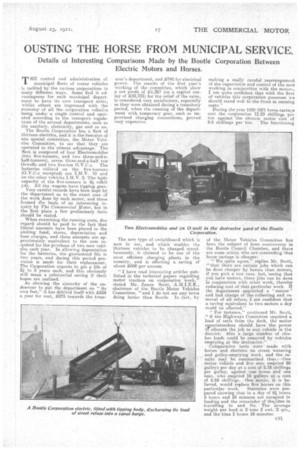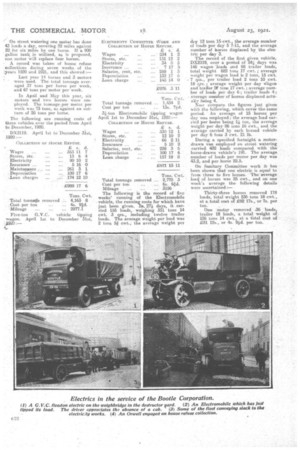OUSTING THE HORSE FROM MUNICIPAL SERVICE.
Page 17

Page 18

If you've noticed an error in this article please click here to report it so we can fix it.
Details of interesting Comparisons Made by the Bootle Corporation Between Electric Motors and Horses.
THE control and administration of municipal fleets of motor vehicles is tackled by the various corporations in many different ways. Some find it advantageous for each municipal department to have its own transport units, whilst otheM are impressed with the economyof all the corporation vehiclas being under a single .eontrol and operated according to the transport regulations of -the several departments' such as the sanitary, electricity, gas and so on.
The Bootle . Corporation has a fleet of thirteen electrics, and it is the function Of one special committee, the Motor Vehi. eles Committee, to see that they are operated to the utmost advantage. The fleet is composed of four Electromobiles (two five-tonners, and two three-and-ahalf-tonners), seven three-and-a-half ton Orwells and two five-ton G.V.C.s. The batteries utilized on the five-tontiers (G.V.c.s excepted) are I.M.V. 10 and on the other vehicles I.M.V. 9. The body capacity of the five-tonners is yds. All the wagons have tipping gear.
Very careful records have been kept by the -department as to the exact cost -of the work done by each motor, and these formed the basis of an interesting inquiry by The Commercial Motor, but in the first place a few preliminary facts should be stated.
When examining the running costs, due regard should be paid to the fact that liberal amounts have been placed to the. sinking fued, stores, depreciation arid loan charges, and these amounts are approximately equivalent to the sum re, quired for the purchase of two new vehicles each year. In allowing depreciation for the batteries, the guaranteed life is two years, and during this period .provision is made for their replacement. The Corporation expects to get a life of 2i to 3 years each, and this obviously will mean a substantial saving if their hopes are realized.
As showing the sincerity of the endeavour to put the department on " its ' own feet," it has debited itself with 2554 a year for rent, 2275 towards the treas urer's department, and £740 for electrical power. The results of the first year's Working of the committee, which show a net profit of £1,387 (on a capital out, lay of 22,751) for the relief of the rates, is considered very satisfactory, especially as they were obtained during a transitory period, when the running of the depart-. ment with temporary gear, such as improvised charging connections, proved very expensive.
The new type of switchboard which is now in Use, and which enables the thirteen vehicles to be charged -.simultaneously, is claimed to be one of the most. efficient charging plants in the country, and is effecting a saving of about £500 per annum.
"I have read interesting articles published in the technical papers regarding motor traction on corporation work. ' stated Mr. James Scott, A.M.I.E.E., chairman of the Bootle Motor Vehicles Committee, "and I do not see any town doing better than Bootle. In fact, by making a really careful rearrangement of the supervision and control of the men working in conjunction with the motors, I am quite confident that with the fleet ofvehicles this corporation possesses we should stand well to the front in running costs."
During the year 1920-1921 horse cartassait cost the corporation 12.29 shillings per ton against the electric motor cost of 9.6 shillings per ton. The functioning
of the Motor Vehicles Committee has been the subject of keen controversy in the Bootle Council Chamber, and there are some critics who are contending that horse cartage is cheaper.
• " We quite agree," replies Mr. Scott, " that there are certain jobs which can be done cheaper by. horses than motors, if you pick a test case. but, 'seeing that you have motors, these jobs can be done m conjunction with other work, thereby reducing, cost of that particular work. If the department appointed. a ` runner ' and had charge of the collecting and re. -moval of all refuse, I ant confident that a saving equivalent to two motors a day could be effected."
" For instance," continued Mr. Scott, " if the Highways Committee required a load of setts from the dock, the Motor superintendent, should have the: power t5 allocate the job to any., vehicle in 'the district. Also a large number of clinker loads could be removed by. Vehicles emptying at. the destructor." Comparative tests were' made with horses and electrics on street watering and. gulley-emptying work, and the re .stilts may be summarized. thus :—One motor. Vehicle and five men 'emptied 80 gulleyS per day at a cost of 2.18 shillings per gulley, against one horse and one man, who emptied 16 gulleys at, a cost of 2.68 shillings. One motor, it is believed, would replace five horses on this
particular work. Statistics were prepared showing that in a day of si hours 5 hours and 59 minutes are occupied in
loading and the remainder of the,time in travelling to and fro. The. average "weight per load is 2 tons 3" cwt. 2. qrs., and the time 2 hours 55 minutes. ••'• On street watering one motor has done 43 loads a day, covering 22 miles against 22 for six miles by one horse. If a 900 "gallon tank is utilized, as is proposed, one motor will replace fear horses.
• A record was taken of house refuse collections during seven weeks of the :years 1920 and 1921, and this showed:— Last year 14 horses and 3 motors were used. The total tonnage averaged 37 ions per horse per week, and 67 tons per motor per week.
In Apsil and May this year, six motors and two horses were employed. The tonnagedDer motor per week was 73 tons, as against art outturn. of 26 tons per horse.
The following are running coats of three vehicles over the period from April to December, 1220.
DX2119. April 1st to 'December 31st, 1920:— 'Total tonn.ate removed 4,163 8 Cost per ton 4s. 92d.
Mileage 2977.1
Five-ton G.V.C. vehicle tipping wagon. April 1st to December 31st,
ELECTRICITY COMMITTEE WORK AND COLLECTION 01 HOUSE REFUSE.
Total tonnage removed .„ 1,434 2 Cost per ton ... ... 13s. 70.
• %-ton Electromobile tipping wagon April 1st to December 31st, 1920 :— COLLECTION OF ROUSE REFUSE. s. d.
The following is the record of five weeks' running of the Electromobile vehicle, the running costs for which have just been given. In. 27i days, it...carried 155 loads, weighing 351 tons 14 cwt. 3 qrs., including twelve trailer loads. The average weight per load was 2 tons 5i cwt., the average weight per (ley 12 tons 15•cwir., the average number of loads per day 5 7-11, and the average /timber ef horses displaced by the elec. tric per day 3.
The record of the first given vehicle, DX2/19, over a period of 244 days was 146 wagon 'loads and 98 trailer loads, total weight 682 tons 17 cwt.; average weight per wagon load in 2 tons, 15 cwt. 7 qrs., per trailer load 2 tons 10 cwt. 18 qrs.; average weight per. day nragou and traitfer 2t tons 17 ewt.; average number of loads per day 6; trailer loads 4; average number of horses displayed actualiy being 4.. ticcor compare. the figures. just given with the following, which cover the same period. An average of 15 horses per day was employed; the average load carried. per horse being 1i ton, the average weight per day 96 tons 16 cwt., and the average carried by each horsed vehicle per day 6 tons 3 cwt. 21 lb.
During a specified fortnight a motordrawn van employedon street watering carried 432 loads compared with the horse-drawn vehicle's 191. The ,average number of loads per motor per day was 43.2, and per horse 22.5.
On Sanitary Committee work it has been shown that one electric is equal to from three to five horses. The average load of horses was 25 cwt., and on one woelr's average the following details were ascertained :—
Thirty-three horses removed. 174 loads, total weight 236 tons 18 cwt., at a total cost of 282 17s., or 7s, per ton.
One •motor removed .36 loads, trailer 18 loads, a total weight of 156 tons 14 cwt., at a tbtal cost of £31 12s., or 4s. 90. per ton.
































